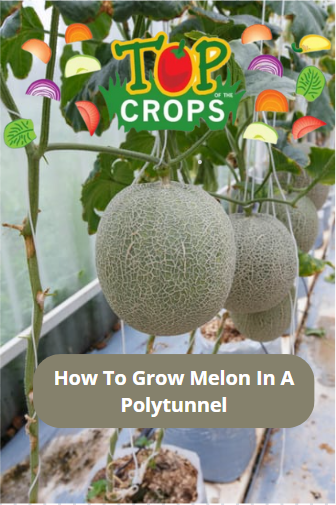Welcome to the top of the crops. Today you will learn how to grow melon in a polytunnel.
Melons are certainly not the easiest crop to grow in the UK, though a polytunnel or greenhouse can help. But if you are successful growing melons at home you will certainly enjoy the sweet fruit and the sense of satisfaction at your achievement.
Melons, cucumis melo, come in many different varieties. There are two main types of sweet melon , however, that are grown in the UK – Cantaloupe melon and Honeydew melon.
Cantaloupe melons may sometimes be grown outside in the UK, but will do better undercover. Honeydews cannot really be grown outside here at all and so are considered a greenhouse or polytunnel crop.
Grafted melons are now available which may be easier to get to crop in the UK, but whether you choose these or not, selecting the right melon variety to grow is key to your success. Find suggested varieties towards the end of this guide.
| JAN | FEB | MAR | APR | MAY | JUN | JUL | AUG | SEP | OCT | NOV | DEC | |
| SOW |  |
|||||||||||
| PLANT |  |
 |
||||||||||
| HARVEST |  |
 |
 |
In the UK, it is not usually possible to successfully grow sweet melons outside. This is where a polytunnel really comes in handy – in increasing the range of crops that it is possible to grow in our climate.
Melons require a temperature of around 25 degrees C. throughout the growing season – an unheated polytunnel may provide this in the south, though further north a degree of heating in the polytunnel will likely be required to grow melons equal to those that can be grown in warmer climes.
Remember, melons need:
Melons will do best in raised beds or in the ground where the soil is suitable, but they can also be grown in pots at least 45cm in diameter.
To grow melons you will need:
Melon seeds or starter plants.
A greenhouse, polytunnel or at the minimum cloches for outside growing.
Seed trays, small pots, and seed starting potting mix, and ideally a heated propagator for seed germination.
A trowel/ spade for planting out.
Facility to water your crop.
Organic matter for mulch and organic liquid plant feed.
Potentially support for vertical growing.
Melon does require careful planning and preparation to grow successfully. First of all, you will need to make decisions about whether you will grow from seed, and if so, where and when you will sow.
While you can grow melons from starter plants, purchased from a garden centre or plant nursery, by far the cheapest and most sustainable option is to grow these plants from seed. In the UK direct sowing is not the best option. It is best to sow the seeds indoors in mid to late April.
It is best to sow two melon seeds into small pots or soil blocks, to a depth of around 1.5cm. Once the seeds germinate, if two emerge the weakest should be removed.
Seeds need to be kept at between 18 and 21 degrees C. for germination to take place, and so it is best to use a heated propagator if possible for the best germination rates. However, if a heated propagator is not available then a consistently sunny and warm windowsill may work.
When melon seedlings or young plants have three-four leaves, they can be planted out into their final growing positions. It is important to make this transition as smooth and seamless as possible, without a precipitous drop in temperature, since this can lead to a check in the plant's growth, or even kill it
As a general guideline, you should be able to plant melons into a greenhouse or polytunnel from late May onwards – and outdoors after the hardening off process from early to mid June - though remember that temperatures must consistently remain above 12-15 degrees C..
Plants are typically spaced around 45cm apart when growing vertically, and at least 90cm apart if they are trailing on the ground.
When planting in a greenhouse or polytunnel you might plant your melons in the ground, in a raised bed, or in a container that is at least 45cm wide and deep. A standard growing bag will hold a couple of plants.
Remember to get your supports in place before planting and prepare the growing area, making sure you are meeting the plants' basic environmental growing needs.
Remember that you will need to harden off your plants before you plant them outside, and that it may be beneficial to use cloches or row covers to warm the soil before planting.
Remember that most melons will not thrive outside in the UK, and so you will have to carefully select a suitable variety for outdoor growing. Even for the right varieties, only a very warm, sheltered location with fertile, free-draining soil, where temperatures remain above 12-15 degrees C. at all times will work.
Melons are certainly not a suitable crop for those who do not have plenty of time to tend their gardens. They need plenty of care and attention to grow and fruit well.
Water melons consistently throughout the growing season to keep the soil moist but not waterlogged. Always make sure excess water can drain away freely and that water does not pool around the base of the stem or it may rot. Try to water below the plants, and not to wet the foliage, as this can increase the likelihood of a fungal infection taking hold.
Add a thick layer of organic mulch such as homemade compost or well-rotted manure around the base of your melon plants, leaving a gap around the stem so that it does not rot. This mulch will add slow-release fertility, protect the soil, conserve soil moisture and suppress weed growth to a degree.
Melons are 'hungry' plants and so in addition to providing a fertile, humus-rich soil and mulching with organic matter, you should also feed your plants with an organic, liquid plant feed.
A comfrey tea or other liquid plant feed high in potassium should be provided once a week from when the fruits first form to when the foliage dies back at the end of summer.
Melons are best provided with some support in order to grow them vertically and make the most of the space you have available. They can be allowed to trail along the ground, but this will take up a lot more of your valuable growing area.
There are a number of different supports that you can create, to which melon plants can cling with their twining tendrils. There are a great many different trellis options, and you can also cordon the plants if you choose to grow and train them in that way.
Remember, melons need relatively high temperatures and high humidity in order to grow and fruit well. But try to maintain temperatures of 18-25 degrees and not too much higher. Ventilate on very hot days and put up shading where necessary when growing in a greenhouse to avoid leaf scorch.
Raise humidity in a greenhouse or polytunnel on hot days in summer by damping down hard surfaces and allowing the water to evaporate. Keeping the humidity high should help you avoid issues with common pests like red spider mites and common fungal issues like powdery mildew.
To encourage the plants to produce fruit, and to ensure good fruit formation:
Attract pollinators and ensure they can access melons in flower even when they are growing under cover.
But restrict pollinator access by covering melons until there are several flowers for pollination, otherwise the first fruit set can inhibit further fruit production.
In greenhouses and polytunnels, hand-pollination will often be required. You can transfer pollen manually with a small brush between male and female flowers.
Once fruits form, limit their number to ensure that they can ripen. You should leave no more than four fruits on outdoors plants, and 4-6 on greenhouse/ polytunnel plants. Remove all other fruits and flowers, making sure you have no more than 2 fruits on a particular side shoot. Remove all growth beyond the outermost fruit you are retaining on each shoot.
If plants have been allowed to trail on the ground, place a tile or piece of wood below each fruit so they do not lie in contact with the soil which can lead to rot.
Support fruits on climbing melons with netting hammocks or similar.
Use cloches, row covers, fleece etc. to keep plants safe at the end of the growing season, to give fruits as much time to ripen as possible.
It really can be very challenging to grow melons successfully in the UK. The main challenge is maintaining enough sun and the right temperatures over the whole of the growing season. Melons are also hungry and thirsty plants, needing the right watering and feeding to grow and fruit well.
Results will unfortunately often be disappointing if melons are grown outdoors, and even when growing undercover the results can sadly be underwhelming. Even if you do everything right, the weather conditions alone may mean that you struggle...
Aside from issues arising from the environmental conditions or care, melons can also experience issues with pests, including slugs, snails, aphids, red spider mites and whitefly... and they can get a number of different fungal diseases including powdery mildew and verticillium wilt.
Another problem that can kill melon plants is cucumber mosaic virus, which also attacks these related plants. This is often spread by sap-sucking insects.
If you have done everything right, you should be able to harvest melons from a polytunnel garden in the mid to late summer, perhaps into early autumn. Make sure that your hard work does not go to waste by knowing the best time to harvest the fruits.
Melons, when ripe, will have a distinctive melon smell. They will also start to crack near the stem. You should be sure to eat ripe fruits as soon as possible after harvesting, ideally still warm from the sun.
Companion planting in your polytunnel can also help lead to good results. Consider companion plants for melons such as nasturtiums, radishes, and climbing beans for nitrogen fixation.
Pire, T., (2022) 21 Types of Melons to Load Up on While They’re in Season. Pure Wow. [online] Available at: https://www.purewow.com/food/types-of-melons
